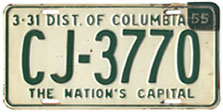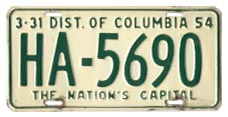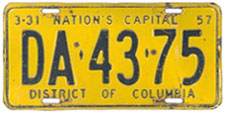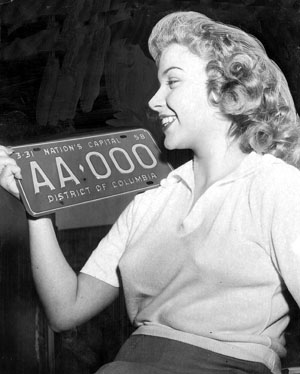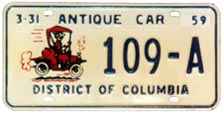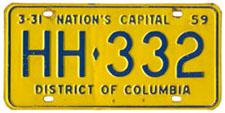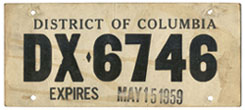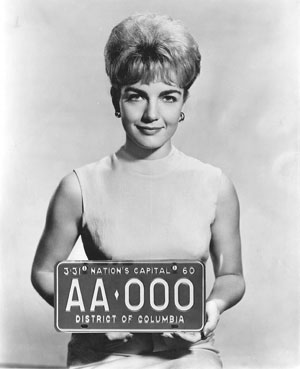License Plates and Registration Numbers
from April 1950 to March 1960
 |
1950 April 1, 1950-March 31, 1951 |
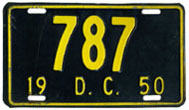 |
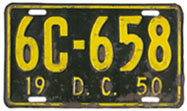 |
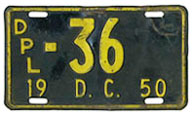 |
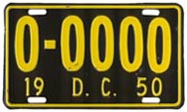 |
Unlike 1951 and later years, official documentation in which 1950 Washington, D.C. license plates are described has not been located. Data presented below (except registration statistics) has been compiled from alternative sources and based upon examination of 1950 plates. Furthermore, assumptions have been made regarding characteristics that are not likely to have been changed from previous and subsequent years. |
|
|
|||||||||||||||||||||||||||||||||||||||||||||
|
|
|
An overview of registration numbers used from April 1948-March 1955 is provided on our page upon which plates of the 1940s are described. Click here to get there. Passenger. These eight prefix letters have been observed on 1950 auto plates: A, E, F, J, K, N, P, and S. If it is assumed that no other prefix letters were used this year and including the 99,999 plates without a letter prefix (numbers 1 through 9-9999), there are a total of 179,991 possible passenger registration number combinations. The highest observed number is S-4771. Non-Passenger. Refer to the 1948-55 registration numbers section referenced above for information about to which non-passenger types plates with prefix letters B, C, D, G, H, L, M, R, and T, as well as DPL, were assigned. |
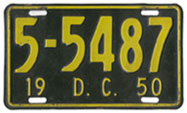 |
 |
|
Although mention of reserved registration numbers calls to mind low numbers and combinations comprised of repeating digits and other noticeable characteristics, even certain nondescript registrations were assigned to the same motorist year after year, presumably only if the assignee arranged for it. These two plates are thought to have been used by the same person and kept together for over 60 years. |
||
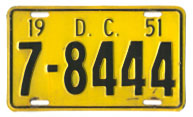 |
1951 April 1, 1951-March 31, 1952 |
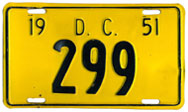 |
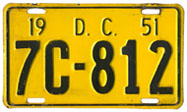 |
 |
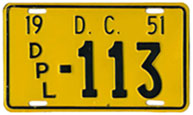 |
 |
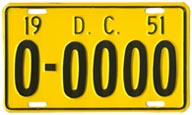 |
This general information about numbering formats utilized on 1951 Washington, D.C. license plates was included in the April 1950 document referenced below: "Not more than a single letter or numeral prefix and four digits, or a single numeral and single letter and three digits shall be used on any plate; no series of numbers shall commence with the figure "0". Reference to classifications shall be by letter symbol rather than by full name designation." |
|
|
||||||||||||||||||||||||||||||||||||||||||||||||
|
|
|
An overview of registration numbers used from April 1948-March 1955 is provided on our page upon which plates of the 1940s are described. Click here to get there. Passenger. These seven prefix letters have been observed on 1951 auto plates: A, E, J, K, N, P, and S. If it is assumed that no other prefix letters were used this year and including the 99,999 plates without a letter prefix (numbers 1 through 9-9999), there are a total of 169,992 possible passenger registration number combinations. The highest observed number is S-1756. Non-Passenger. Refer to the 1948-55 registration numbers section referenced above for information about to which non-passenger types plates with prefix letters B, C, D, G, H, L, M, R, and T, as well as DPL, were assigned. |
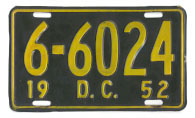 |
1952 April 1, 1952-March 31, 1953 |
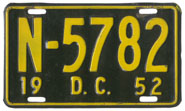 |
 |
 |
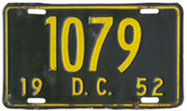 |
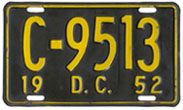 |
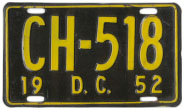 |
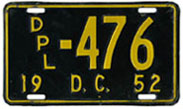 |
 |
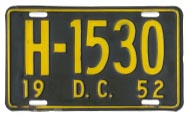 |
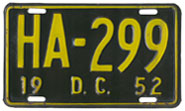 |
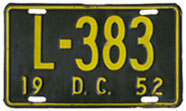 |
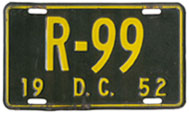 |
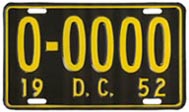 |
 |
The last of five consecutive annual plates marked with the year of issuance, not the expiration date, was issued in the spring of 1952. Beginning with the 1952 registration year, D.C. Government plates were changed from standard-looking plates with a G prefix to red-on-white plates with three stars, representing the city government's three commissioners, embossed vertically on the left side. D.C. GOVT. is stamped at the bottom. Smaller plates, also red on white, were issued for government-owned motorcycles, although whether they include three stars is unknown. Plates of both sizes were considered permanent upon their introduction. "The numerals shall commence with 1 and continue in sequence to as high a number as is necessary," according to a March 27, 1951, memo with which the new series was established. Plates of these two government types were not issued for use on police and fire department vehicles because separate types already existed for those agencies. Plates with a letter G prefix were released from restriction and issued to owners of privately-owned passenger vehicles. Due to metal rationing in conjunction with the Korean War in early 1951, as 1952 plates were being planned, officials considered issuing only on plate per vehicle for this registration year. Click here to read more about this topic. |
|
|
||||||||||||||||||||||||||||||||||||||||||||||||
|
|
|
An overview of registration numbers used from April 1948-March 1955 is provided on our page upon which plates of the 1940s are described. Click here to get there. Passenger. These eight prefix letters have been observed on 1952 auto plates: A, E, F, G, J, K, N, and P. If it is assumed that no other prefix letters were used this year and including the 99,999 plates without a letter prefix (numbers 1 through 9-9999), there are a total of 179,991 possible passenger registration number combinations. The highest observed number is P-257. Non-Passenger. Refer to the 1948-55 registration numbers section referenced above for information about to which non-passenger types plates with prefix letters B, C, D, H, L, M, R, and T, as well as DPL, were assigned. |
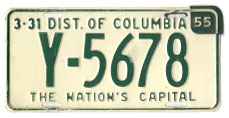 |
1953, '54 April 1, 1953-March 31, 1955 |
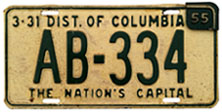 |
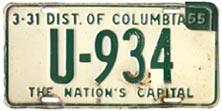 |
|
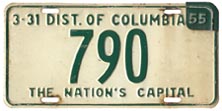 |
 |
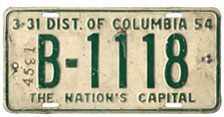 |
|
 |
 |
|
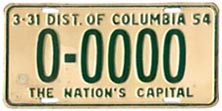 |
It could be argued that the 1953 license plate is more different from its immediate predecessor than is a D.C. plate of any other year. It can, in fact, take time for even some experienced plate collectors to recognize that the sloganless, yellow-on-black dated 1952 plate was immediately followed by the green-on-white dated 3-31-54 issue, the first Washington, D.C. plate to include a slogan. With the exception of Antique Car plates and some U.S. Govenment plates marked DISTRICT OF COLUMBIA, this was the last D.C. plate to be revalidated with a tab. Perhaps most interesting about plates of this two-year period is what didn't happen for 1954. In a May 1, 1952, memo, officials indicated that it was their intention that new plates be issued for that registration year, and that they feature "the identification number in blue with all other letters and figures in red on a white background." As described on a separate page in which the development of 1953 plates and 1954 ("55") tabs is presented, this plan was scuttled due to the higher cost of tri-color plates, such as were already being used by the federal government. Also noteworthy about the 1953 plate is that it is the first (since 1917) made in the 6"x12" format that was to become the national standard a few years later. |
|
|
||||||||||||||||||||||||||||||||||||||||||||||||||||||||||||
|
|
|
Passenger. The passenger section of the overview of 1948-52 registration numbers that appears on our page upon which plates of the 1940s are described also applies to how 1953 baseplates are numbered. Click here to get there. Furthermore, an additional series, which is only discussed below because it was not used in other years, was required for this base because it was the general-issue base for two years, not just one. Whereas no more than eight prefix letters were used on any single one-year base issued from 1948 through 1952, 14 letters were used on the two-year 1953 baseplate, and even those weren't quite enough. Specifically, these prefix letters were used on 1953 baseplates: A, E, F, G, J, K, N, P, S, U, V, W, Y, and Z. (Taking into consideration letters set aside for use exclusively on non-passenger plates, only I, O, Q, and X were left unused.) If it is assumed that no other single-letter prefixes were used this year and including the 90,999 plates without a letter prefix (numbers 1 through 9-9999), there are a total of 230,985 possible passenger registration number combinations using the standard all-number and single-letter-prefix combinations. However, 230,985 passenger registration combinations were apparently not quite enough to get through the two-year life of this base. Therefore, a short run of plates with two-letter prefixes was introduced, presumably towards the end of the 1954-55 registration year. Numbers in this series began at number AA-1 and progressed to AA-999, then began at AB-1 and proceeded sequentially. The plate with the highest verified number, AB-334, is shown above. Non-Passenger. Refer to the 1948-52 registration numbers section referenced above for information about to which non-passenger types plates with prefix letters B, C, D, H, L, M, R, and T, as well as DPL, were assigned. As in previous years, after the first series of plates of a particular type was exhausted, a serial letter was added following the type designation letter. Two examples are shown above. For example, after Hire (Taxi) plates H-1 through H-9999 were assigned, plates beginning with HA were issued. However, it is still unclear whether these two-letter-prefix plates were numbered beginning at 1 (i.e. HA-1) or 1000. |
 |
1955 April 1, 1955-March 31, 1956 |
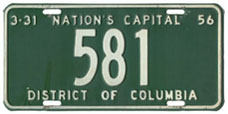 |
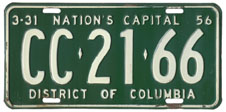 |
|
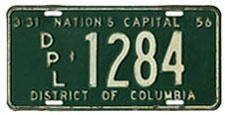 |
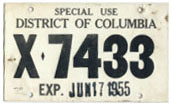 |
|
 |
Continuing through a period of unprecendented and unpredictable change, District of Columbia license plates issued in the spring of 1955 bear little resemblance to the 1953 two-year plates that they replaced. The color scheme was new, the slogan slightly modified, and the registration number configured in a completely new format for auto plates (although it had been introduced for non-passenger plates two years earlier). This last change is addressed (although the reason for its adoption is not explained) by the Dept. of Vehicles and Traffic in a memorandum of May 21, 1954: "Numerals following the prefix [letters] shall start with 10-00 and end with 99-99." The configuration was presumably adopted in order for Washington, D.C. plates to more closely |
resemble those of neighboring Maryland, which had used the AB-12-34 format since April 1953, but it was abandoned by D.C. after only two years due probably to having far more possible registration number combinations than this small jurisdiction would ever need. Even today, with it having made a return, it will take decades to use all of the possible combinations from AA-0000 through ZZ-9999. Not only was the new numbering format likely copied from Maryland, but so too was the use of small diamond separators. Maryland first used diamonds on its 1954 (dated "55") plates, which were in use, and much in evidence in Washington, when the District's 1955 plates were designed. |
|
|
||||||||||||||||||||||||||||||||||||||||||||||||
|
|
|
Background information about the numbering configuration introduced for 1955 is provided above. Passenger - General-Issue. Numbers commenced at AA-10-00 and progressed through AA-99-99, at which point numbers in the EA series began to be issued because plates beginning with B, C, and D were used for non-passenger service. The highest observed plate is EA-64-73. It seems unlikely that A-series plates with certain letters in the second position, such as I, O, and Q, would have been made and issued, but the May 1954 DMV internal documentation in which registration numbers for the 1955 registration year are specified defines the passenger prefixes as simply "AA to AZ." Conversely, when in Sept. 1954 the E series was designated as being available for passenger use (presumably while the plates were actually being made), the amended list of 1955 plate prefixes appears thusly: "AA to AZ - Passenger cars only; EA to EY (omitting EF, EI, EO, and EQ) - Passenger cars only." Based upon historical precedent in D.C. and elsewhere and although contrary to conventional wisdom, it is reasonable to assume that the aforementioned memoranda do not contain accurate information. Although no A-prefix letter series are specified as being omitted from the sequence of plates made and issued, it is almost certain that the AI, AO, and AQ series were not used. Furthermore, based upon later information about 1955 and 1956 plates (plates of both years, but only these two years, are numbered in the same format), a case could be made that AF-, AK-, and/or AZ-series plates were also not issued for 1955. Passenger - Reserved. Numbers 1 through 1000 were assigned by the Board of Commissioners. Non-Passenger plates of 1955 continued to be numbered in a format introduced in 1953, the only change being the addition of a dash between the second and third number in order that they closely resemble auto plates. Therefore, for example, Bus plates began at BA-10-00, Commercial plates began at CA-10-00, etc. The numbering of Motorcycle and Diplomatic plates continued to begin at M-1 and DPL-1, respectively. Specifically, here are the eight most common non-passenger types made on the 1955 base and the first assigned number of each: Bus, BA-10-00; Commercial (Truck), CA-10-00; Dealer, DA-10-00; Diplomatic, DPL-1; Hire (Taxi), HA-10-00; Livery, LA-10-00; Motorcycle, M-1; and Trailer, T-10-00 (not TA-10-00). |
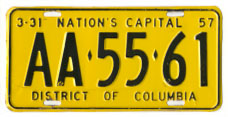 |
1956 April 1, 1956-March 31, 1957 |
 |
 |
|
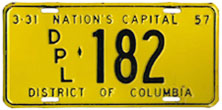 |
 |
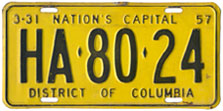 |
|
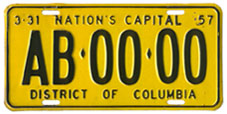 |
According to an April 1955 DMV memo in which the production of 1956 plates is discussed, plates for the new year were to be made with a lighter-gauge steel "to save postage expense." Specifically, the memo indicates that 1955 plates are 24-gauge metal whereas 1956 plates were to be made with 26-gauge stock. |
|
|
||||||||||||||||||||||||||||||||||||||||||||||||
|
|
|
District of Columbia plates continued to use the "numbering system adopted for 1955 plates with no low or special numbers, except those assigned by Commissioners" according to an April 4, 1955, memo in which plates planned for 1956 are described. Background information about the 1955 and 1956 numbering configuration is provided above. Furthermore, some detailed information presented above about 1955 Registration Numbers is also relevant to1956 plates. Passenger - General-Issue. Numbers commenced at AA-10-00 and progressed as high as necessary (but see information below as to certain letter series presumably not used) through the A series and into the E series. The highest observed plate is EA-87-23. During the 1956 registration year a portion of the C (Commercial/Truck) series was set aside for passenger registrations as an "overflow" series, but it is doubtful that any were issued for passenger service. An April 1955 DMV internal documentation in which registration numbers for the 1956 registration year are specified defines the passenger prefixes as "AA to AY (omitting AF, AI, AK, AO, AQ) - Passenger cars only; EA to EY (omitting EF, EI, EO, EQ) - Passenger cars only." According to a memorandum dated January 17, 1957, which was 9.5 months into the life of the 1956 plates, the supply of commercial plates was amended to include only plates numbered through CC-20-00, with higher-numbered CC-series plates, namely CC-20-01 through CC-99-99, being released for issuance to private auto owners. Passenger - Reserved. Numbers 1 through 1000 were assigned by the Board of Commissioners. Non-Passenger plates of 1956 are numbered in some same format as 1955. Specifically, here are the eight most common non-passenger types made on the 1956 base and the first assigned number of each: Bus, BA-10-00; Commercial (Truck), CA-10-00; Dealer, DA-10-00; Diplomatic, DPL-1; Hire (Taxi), HA-10-00; Livery, LA-10-00; Motorcycle, M-1; and Trailer, T-10-00 (not TA-10-00). |
|
|
|
The use of new, shorter dies and a new numbering format for all types (except Commercial, Motorcycle, Trailer, and Diplomatic) effective April 1957 was described by the Dept. of Vehicles and Traffic in a memorandum of Feb. 9, 1956, from which three particularly relevant passages have been excerpted: "For the registration year commencing April 1, 1957, the motor vehicle identification tags shall be of uniform size...with 2 5/8" letters and numerals patterned after the national standard adopted by the American Association of Motor Vehicle Administrators." "Except for numbers 1 to 1000, inclusive, which are assigned by the Board of Commissioners, all tags shall bear a prefix of two letters followed by three numerals (except commercial which shall be numbered from CA-1000 to CZ-9999, and motorcycles and trailers which shall be numbered from M 1 and T 1 and up, respectively)... Numerals following the lettered prefix shall start with 100 and end with 999. All tags, except numbers 1 to 1000 and diplomatic tags, shall be issued in strict sequence and shall not be held or reserved for any applicant for registration." "The dies used by the Lorton Reformatory for manufacturing the District's automobile license tags are worn out and must be replaced for next year's issue. It seems appropriate at this time to recommend a new identification system which will be much simpler and easier for the public to remember, and since there is an adequate supply of numbers available for this purpose, we are recommending that each passenger car tag have not more than two letters and three numbers instead of two letters and four numbers as now. The present system is being retained for commercial vehicle tags. The prefix of all of the commercial series starts with "C" and there would not be sufficient numbers available for this purpose if the passenger car numbering system were followed." Passenger - General-Issue. Numbers commenced at AA-100 and progressed as high as necessary annually. First-position letters observed for each year are listed in each year section below. Throughout this period 22 second-position letters were available, with only F, I, O, and Q not used. Plates in all two-letter series used are numbered 100 through 999. Passenger - Reserved. Numbers assigned by the Board of Commissioners during ths era were 1 through 1200 for 1957-1959, and 1 through 1250 for 1960-1963. Although the Feb. 9, 1956, memorandum quoted above indicates that 1957 reserved plates would be numbered from 1 only through 1000, that directive was superseded by a separate memo dated March 7, 1957, that effectively increased the number of available reserved plates by 200. Non-Passenger. With the exception of R, as discussed here, letter prefixes set aside for various non-passenger types since 1948 continued to be use during this era. As since 1953, in most cases the type designation letter is followed by a serial letter, but now there are only three numbers following, not four. For example, 1957-63 Bus plates began at BA-100. Plates of three types continued to be numbered in the manner of 1955 and 1956 plates: Commercial, Motorcycle and Diplomatic plates began at CA-1000, M-1 and DPL-1, respectively. Specifically, here are the eight most common non-passenger types issued from 1957 to 1963 and the first assigned number of each: Bus, BA-100; Commercial (Truck), CA-1000; Dealer, DA-100 (although all-number plates were issued for 1961); Diplomatic, DPL-1; Hire (Taxi), HA-100; Livery, LA-100; Motorcycle, M-1; and Trailer, T-100. Detailed information about how non-passenger plates of this era are numbered may be found on pages devoted to various types, such as Commercial, Hire, and Rental Car. |
 |
1957 April 1, 1957-March 31, 1958 |
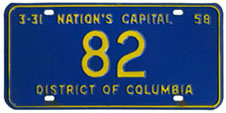 |
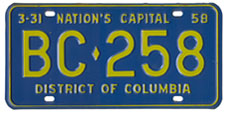 |
|
 |
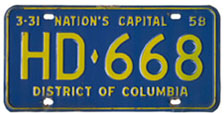 |
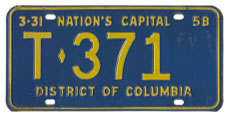 |
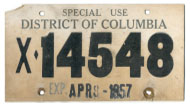 |
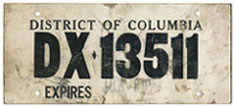 |
Almost everything about 1957 Washington, D.C. license plates was new. A completely new color scheme, new dies, and a new numbering format resulted in a plate that appeared unlike any issued during the first half-century that they were provided by the District government. Even subtle differences, such as dies used to stamp the expiration date and the size of bolt holes, are found to have been changed upon close inspection. Detailed information about the new dies and numbering format are provided above. |
Information about Commerical (Truck) plates retaining characteristics of 1956 plates rather than being made with the new 1957 dies may be found in the 1955-64 section of our page dedicated to this type. It is also worth noting that the color of 1957 plates was originally intended to be white on dark green, the same color scheme as 1955 plates. Why the change to yellow on blue was made is unknown. |
|
|
||||||||||||||||||||||||||||||||||||||||||||||||
|
|
|
An overview of 1957-1963 registration numbers is provided above. Passenger - General-Issue. These ten prefix letters have been observed on 1957 auto plates: A, E, G, J, K, M, N, P, R, and S. The highest observed number is SZ-727. The number of general-issue registration number combinations from AA-100 through SZ-727 is 197,728. Passenger - Reserved. Numbers 1 through 1200 were assigned by the Board of Commissioners. Non-Passenger. Refer to the text above for information about to which non-passenger types plates with prefix letters B, C, D, H, L, M, and T, as well as DPL, were assigned. Bus plates are numbered from BA-100 through BR-999, and plates of the BS series were set aside specifically for use on sightseeing buses. |
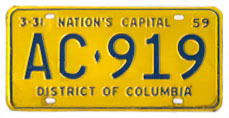 |
1958 April 1, 1958-March 31, 1959 |
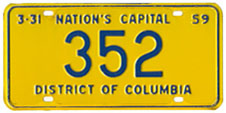 |
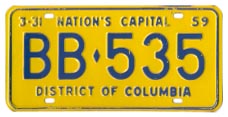 |
|
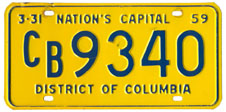 |
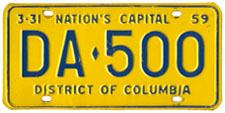 |
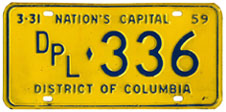 |
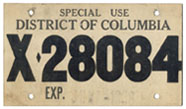 |
|
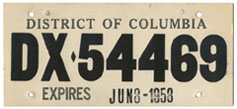 |
 |
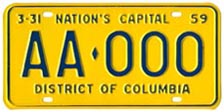 |
Nineteen fifty-seven is the final year for which official correspondence in which D.C. license plates are described has been located. Data presented below (except registration statistics) has been compiled from alternative sources and based upon examination of 1958 plates. Furthermore, assumptions have been made regarding characteristics that are not likely to have been changed from the previous year.
|
|
|
|||||||||||||||||||||||||||||||||||||||||||||
|
|
|
An overview of 1957-1963 registration numbers is provided above. Passenger - General-Issue. These eleven prefix letters have been observed on 1958 auto plates: A, E, G, J, K, M, N, P, R, S, and W. The highest observed number is WB-148. The number of registration number combinations from AA-100 through WB-148 is 198,949. Passenger - Reserved. Numbers 1 through 1200 were assigned by the Board of Commissioners. Click here to read about how reserved numbers were assigned for 1958. Non-Passenger. Refer to the text above for information about to which non-passenger types plates with prefix letters B, C, D, H, L, M, and T, as well as DPL, were assigned. Special Antique Car plates was introduced at the beginning of this registration year, as discussed on a separate page. For 1957 Bus plates were numbered from BA-100 through BR-999 whereas plates of the BS series were set aside specifically for use on sightseeing buses. |
 |
1959 April 1, 1959-March 31, 1960 |
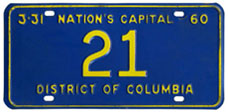 |
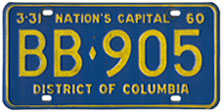 |
|
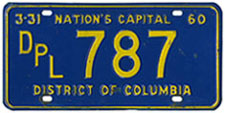 |
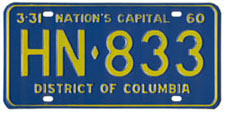 |
|
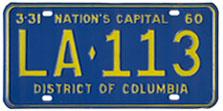 |
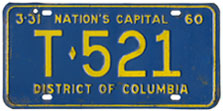 |
 |
|
|
|||||||||||||||||||||||||||||||||||||||||||||
|
|
|
An overview of 1957-1963 registration numbers is provided above. Passenger - General-Issue. These 11 prefix letters have been observed on 1957 auto plates: A, E, G, J, K, M, N, P, R, S, and W. The highest observed number is WK-930. The number of registration number combinations from AA-100 through WK-930 is 206,031. Passenger - Reserved. Numbers 1 through 1200 were assigned by the Board of Commissioners. Non-Passenger. Refer to the text above for information about to which non-passenger types plates with prefix letters B, C, D, H, L, M, and T, as well as DPL, were assigned. |
|
This page last updated on December 31, 2017 |
 |
|
copyright 2006-2018 Eastern Seaboard Press Information and images on this Web site may not be copied or reproduced in any manner without consent of the owner. For information, send an e-mail to admin@DCplates.net |















